Modified Starch Market Research, 2032
The global modified starch market was valued at $9.0 billion in 2022, and is projected to reach $14.4 billion by 2032, growing at a CAGR of 4.9% from 2023 to 2032.
Report Key Highlighters:
- The report provides competitive dynamics by evaluating business segments, product portfolios, target market revenue, geographical presence and key strategic developments by prominent manufacturers.
- The modified starch market is fragmented in nature among prominent companies such as ADM, AGRANA Beteiligungs-AG, AVEBE U.A., Cargill, Incorporated, EMSLAND GROUP GmbH and Co. KG, Ingredion Incorporated., Roquette Freres, Royal Ingredients Group, and Tate and Lyle PLC.
- The study contains qualitative information such as the market dynamics (drivers, restraints, challenges, and opportunities), key regulation analysis, pricing analysis, and Porter’s Five Force Analysis across North America, Europe, Asia-Pacific, LAMEA regions.
- Latest trends in global modified starch market such as undergoing R&D activities, public policies, and government initiatives are analyzed across 16 countries in 4 different regions.
- More than 2,500 modified starch-related product literatures, industry releases, annual reports, and other such documents of key industry participants along with authentic industry journals and government websites have been reviewed for generating high-value industry insights for global modified starch market.

Modified starch undergoes chemical, physical, or enzymatic modifications to alter its properties and enhance its functionality for specific applications. Starch, a complex carbohydrate, is naturally derived from plant sources such as corn, wheat, potato, tapioca, or rice.
The modification of starch involves various processes that can change its molecular structure, size, solubility, viscosity, gelatinization properties, or other characteristics. These modifications are typically done to overcome limitations of native starch and to meet the specific requirements of different industries such as food, pharmaceuticals, textiles, and paper manufacturing.
The food and beverage industry has experienced significant growth due to factors such as change in consumer preferences, increase in urbanization, and rise in disposable incomes. Modified starch is widely used in the food and beverage industry as stabilizer, thickener, emulsifier, and texture enhancer. It improves the overall quality and sensory attributes of food products, leading to increased demand for these ingredients.
Moreover, modified starch finds applications beyond the food and beverage industry. It is used in industries such as paper & packaging, textiles, pharmaceuticals, cosmetics, and animal feed. For instance, in the paper industry, modified starch improves the strength, smoothness, and printability of paper products. In textiles, t is used as sizing agents and thickeners. The wide range of applications and versatility of modified starch makes them valuable ingredients in these industries, driving its demand.
Furthermore, modified starch offers a wide range of functional properties that make it desirable in various applications. These properties include improved texture, stability, viscosity, and enhanced heat resistance compared to native starch. For example, modified starch can prevent syneresis (liquid separation) in frozen foods, enhance the creaminess of dairy products, and provide better water-holding capacity in meat products. The unique functionalities of modified starch drives its adoption in the food, pharmaceutical, and personal care industries.
However, modified starches are generally more expensive than native starches due to the additional processing and modification steps involved. The higher cost can be a restraint for manufacturers, especially those operating in price-sensitive markets or dealing with tight profit margins.
The cost factor may limit the adoption of modified starches, particularly in price-sensitive applications or regions with budget-conscious consumers. On the contrary, emerging economies, such as China, India, Brazil, and Southeast Asian countries, offer significant growth opportunities for the modified starch industry. These regions have large population with increased disposable income and changed dietary patterns. As a result, there is a surge in demand for processed and convenience foods, which drives the need for modified starches. Moreover, the industrial sectors in these economies, including textiles, paper and packaging, and pharmaceuticals, provide opportunities for the utilization of modified starches in non-food applications.
The modified starch market is segmented on the basis of raw material, type, function, application, and region. On the basis of raw material, the market is categorized into maize, cassava, potato, wheat, and others. On the basis of type, it is divided into cationic starch, etherified starch, esterified starch, resistant starch, and pre-gelatinized. On the basis of function, it is classified into thickeners, stabilizers, binders, emulsifiers, and others. By application, the market is segregated into food & beverages, animal feed, paper-making, weaving textiles, pharmaceuticals, and others. Region-wise, the market is studied across North America, Europe, Asia-Pacific, and LAMEA.
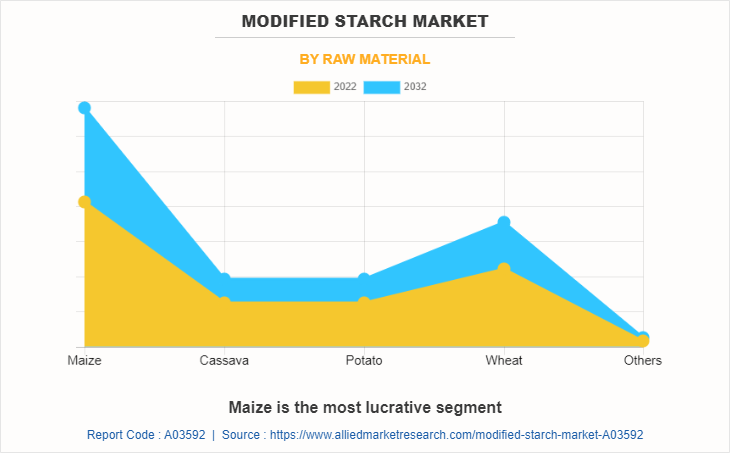
In 2022, the maize segment was the largest revenue generator, and is anticipated to grow at a CAGR of 5.2% during the forecast period. Maize is widely cultivated globally and is one of the most abundant cereal crops. It is readily available in large quantities, making it a reliable and cost-effective source of starch for industrial purposes. Moreover, maize has a high starch content, making it suitable for starch extraction and modification. The starch granules in maize are relatively large and can be easily separated from other components during the extraction process. These factors have increased the utilization of maize as a raw material for producing modified starch.
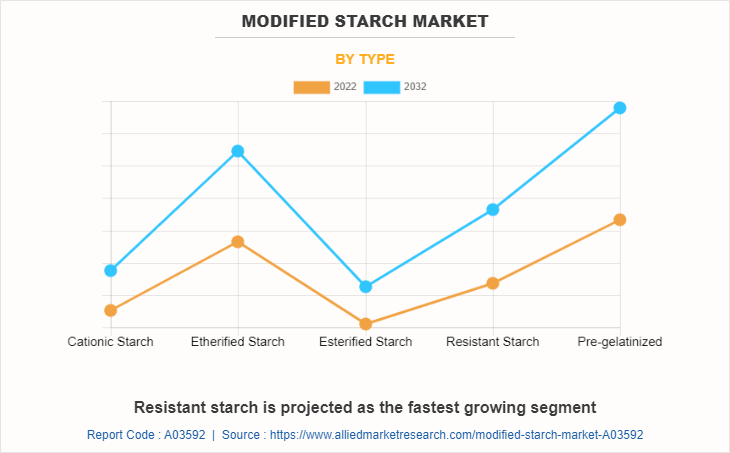
In 2022, the pre-gelatinized segment was the largest revenue generator, and is anticipated to grow at a CAGR of 5.1% during the forecast period. One of the main advantages of pre-gelatinized starch is its instant solubility in cold or hot water. Owing to the partial gelatinization process, the starch granules are hydrated and partially disrupted, allowing them to disperse and dissolve easily in water without the need for cooking or heat. This factor has surged the utilization of pre-gelatinized starch among various applications; thus, fueling the market growth.
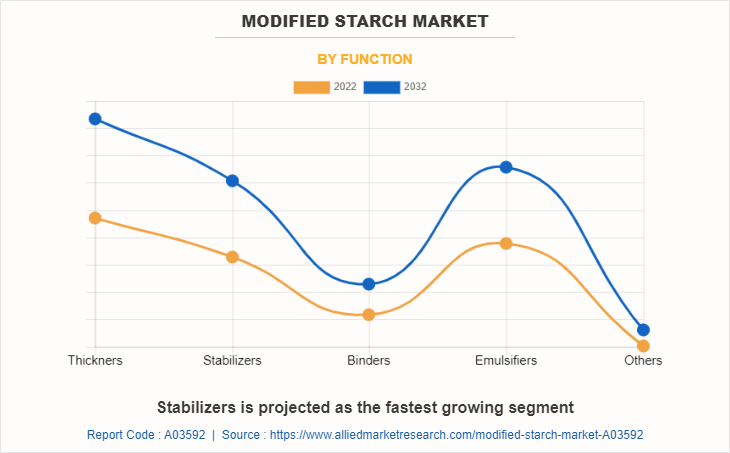
In 2022, the thickeners segment was the largest revenue generator, and is anticipated to grow at a CAGR of 5.0% during the forecast period. Modified starch offers improved functional properties compared to native or unmodified starch. It provides better viscosity control, stability, texture enhancement, and suspension of particles in a wide range of applications. The modification process alters the starch's molecular structure, allowing it to exhibit desired thickening properties under various processing and storage conditions.
Furthermore, consumers increasingly seek products with appealing texture and mouthfeel. Modified starches play a vital role in achieving these desired attributes, providing smoothness, creaminess, and thickness in various food & beverage formulations. They contribute to the sensory experience and overall quality perception of the products. These factors altogether may surge the demand for modified starch for thickener purposes; thus, fueling the market growth.
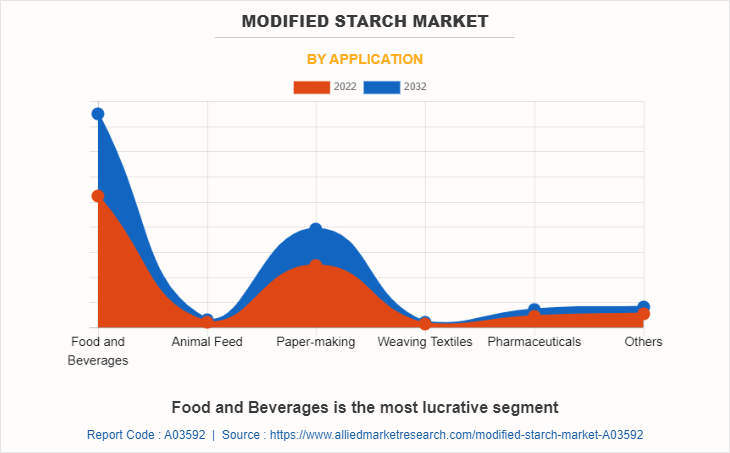
By application, the food and beverages segment dominated the global market in 2022 and is anticipated to grow at a CAGR of 5.0% during forecast period. Modified starches offer a wide range of functional properties that can improve the quality, texture, and stability of food products. They provide thickening, stabilizing, emulsifying, and binding properties, allowing manufacturers to achieve desired product characteristics and meet consumer preferences. This factor may act as one of the key drivers responsible for the modified starch market growth.
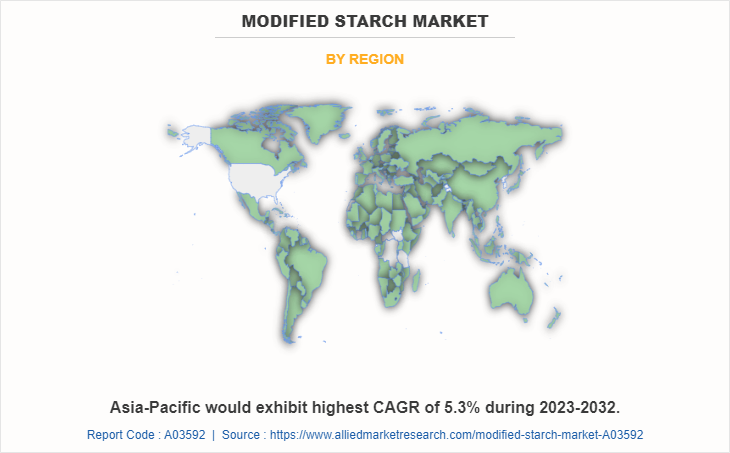
The Asia-Pacific modified starch market size accounted for 37.3% of modified starch market share in 2022 and is projected to grow at the highest CAGR of 5.3% during the forecast period and. Asia-Pacific has witnessed rapid economic growth, population expansion, and increase in urbanization. These factors contribute to the growth of the modified starch market. The region's large population and rise in disposable incomes drive the demand for processed foods, leading to increased utilization of modified starches as functional ingredients.
The modified starch market forecast to grow at a robust rate, fueled by the expanding food and beverage industry and the adoption of modified starches in various non-food applications. Moreover, Asia-Pacific has witnessed a surge in interest in functional foods and nutraceuticals, driven by an increase in health awareness and the desire for preventive healthcare. Modified starches play a vital role in developing functional food products that offer additional health benefits, such as improved digestion, weight management, or cardiovascular health. The demand for modified starches with functional properties is expected to grow as consumers seek healthier food options. In addition to this, clean label and natural ingredients have gained prominence in the Asia-Pacific market as consumers become more health-conscious and seek transparency in their food choices.
The global modified starch market profiles leading players that include ADM, AGRANA Beteiligungs-AG, AVEBE U.A., Cargill, Incorporated, EMSLAND GROUP GmbH and Co. KG, Ingredion Incorporated., Roquette Freres, Royal Ingredients Group, Tate and Lyle PLC, Tereos.
Moreover, other key players in the modified starch market that are not profiled in the report includes Grain Processing Corp., KMC, Roquette Freres, Archer Daniels, Everest Starch, Pars Koosheh Pardaz Co., SPAC Starch Products Ltd., Tongaat Hulett Starch, Eurodona Food Ingredients GmbH, and others. The global modified starch market report provides in-depth competitive analysis as well as profiles of these major players.
Impact Of Covid-19 On The Global Modified Starch Market
- The pandemic led to disruptions in global supply chains, including the transportation and availability of raw materials used in the production of modified starch. Restrictions on international trade, lockdown measures, and reduced workforce availability affected the sourcing and distribution of modified starch products.
- The pandemic highlighted the importance of food security and supply chain resilience. This led to increased emphasis on local sourcing and shorter supply chains, ensuring a stable supply of essential food ingredients, including modified starch. These factors are expected to have implications for the sourcing and production practices of modified starch manufacturers in the future.
Key Benefits For Stakeholders
- This report provides a quantitative analysis of the market segments, current trends, estimations, and dynamics of the modified starch market analysis from 2022 to 2032 to identify the prevailing modified starch market opportunities.
- The market research is offered along with information related to key drivers, restraints, and opportunities.
- Porter's five forces analysis highlights the potency of buyers and suppliers to enable stakeholders make profit-oriented business decisions and strengthen their supplier-buyer network.
- In-depth analysis of the modified starch market segmentation assists to determine the prevailing market opportunities.
- Major countries in each region are mapped according to their revenue contribution to the global market.
- Market player positioning facilitates benchmarking and provides a clear understanding of the present position of the market players.
- The report includes the analysis of the regional as well as global modified starch market trends, key players, market segments, application areas, and market growth strategies.
Modified Starch Market Report Highlights
| Aspects | Details |
| Market Size By 2032 | USD 14.4 billion |
| Growth Rate | CAGR of 4.9% |
| Forecast period | 2022 - 2032 |
| Report Pages | 570 |
| By Raw Material |
|
| By Type |
|
| By Function |
|
| By Application |
|
| By Region |
|
| Key Market Players | Royal Ingredients Group, AGRANA Beteiligungs-AG, EMSLAND GROUP GmbH & Co. KG, ADM, Ingredion Incorporated., AVEBE U.A., Roquette Freres, Tate & Lyle PLC, Cargill, Incorporated, Tereos |
Analyst Review
The modified starch market has experienced significant growth in recent years and is expected to continue to expand. Factors such as the rise in demand for convenience foods, change in dietary patterns, and the need for functional ingredients in various industries (including food, pharmaceuticals, and textiles) drive the market growth. Moreover, consumers have become more conscious of the ingredients used in their food products. A surge in preference has been witnessed for clean label products that contain natural and minimally processed ingredients. In response, many companies focus on offering modified starch derived from natural sources and ensure transparency in labeling and meeting the demands of health-conscious consumers
Furthermore, CXOs added that sustained economic growth coupled with rapid development of pharmaceutical, personal care & cosmetics, and food & beverage sector may lead the modified starch market to witness a significant growth.
Escalating demand from food and beverage sector and robust demand for clean labels are the upcoming trends in the global modified starch market.
Food and beverages is the leading application of modified starch market.
Asia-Pacific is the largest regional market for modified starch.
The modified starch market was valued for $9.0 billion in 2022 and is estimated to reach $14.4 billion by 2032, exhibiting a CAGR of 4.9% from 2023 to 2032
ADM, AGRANA Beteiligungs-AG, AVEBE U.A., Cargill, Incorporated, EMSLAND GROUP GmbH and Co. KG, Ingredion Incorporated., Roquette Freres, Royal Ingredients Group, Tate and Lyle PLC, Tereos are the top companies to hold the market share in the modified starch market.
Loading Table Of Content...
Loading Research Methodology...


